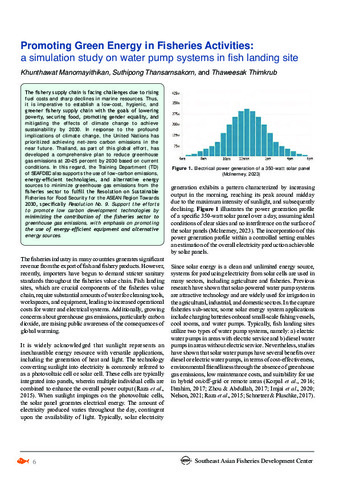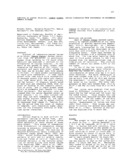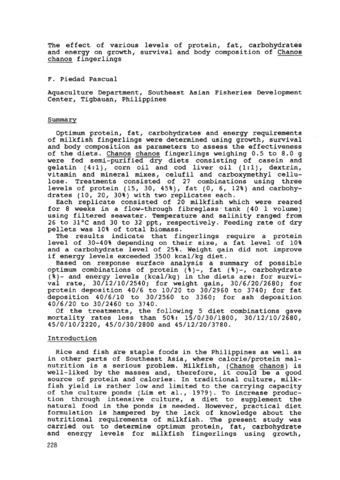Promoting green energy in fisheries activities: a simulation study on water pump systems in fish landing site
Share
ບົດຄັດຫຍໍ້
The fishery supply chain is facing challenges due to rising fuel costs and sharp declines in marine resources. Thus, it is imperative to establish a low-cost, hygienic, and greener fishery supply chain with the goals of lowering poverty, securing food, promoting gender equality, and mitigating the effects of climate change to achieve sustainability by 2030. In response to the profound implications of climate change, the United Nations has prioritized achieving net-zero carbon emissions in the near future. Thailand, as part of this global effort, has developed a comprehensive plan to reduce greenhouse gas emissions at 20–25 percent by 2030 based on current conditions. In this regard, the Training Department (TD) of SEAFDEC also supports the use of low-carbon emissions, energy-efficient technologies, and alternative energy sources to minimize greenhouse gas emissions from the fisheries sector to fulfill the Resolution on Sustainable Fisheries for Food Security for the ASEAN Region Towards 2030, specifically Resolution No. 9. Support the efforts to promote low carbon development technologies by minimizing the contribution of the fisheries sector to greenhouse gas emissions, with emphasis on promoting the use of energy-efficient equipment and alternative energy sources.
Keywords
water pump systemsSuggested Citation
Manomayithikan, K., Thansarnsakorn, S., & Thimkrub, T. (2023). Promoting green energy in fisheries activities: a simulation study on water pump systems in fish landing site. Fish for the People , 21(1), 6-11. http://hdl.handle.net/20.500.12066/7353
ວິຊາ
Collections
Related items
Showing items related by title, author, creator and subject.
-
Voluntary feed intake and energy partitioning in tilapia, (Oreochromis niloticus) fed diets with different protein/energy levels
Santiago, C. B.; Focken, U.; Becker, K. (Wageningen Pers, 2001)In order to investigate the effect of different protein/energy levels of diets (two commercial and one laboratory) on voluntary feed intake and energy partitioning in tilapia (O. niloticus), 15 fishes with an initial body ... -
Survival of larval milkfish, Chanos chanos, during changeover from endogenous to exogenous energy sources
Kohno, Hiroshi; Duray, Marietta; Gallego, Amalia; Taki, Yasuhiko (Asian Fisheries Society, 1990)Survival of laboratory-reared larvae of milkfish, Chanos chanos , during transition from the prelarval to postlarval stages was examined in relation to the changeover of energy sources. The prelarval and early postlarval ... -
The effect of various levels of protein, fat carbohydrates and energy on growth, survival and body composition of Chanos chanos fingerlings
Piedad-Pascual, F. (Center for Agricultural Publishing and Documentation, Pudoc Wageningen, 1989)Rice and fish are staple foods in the Philipines as well as in other parts of Southeast Asia, where calorie/protin malnutrition is a serious probem. Milkfish, (Chanos chanos) is well-liked by the masses and, therefore, ti ...





